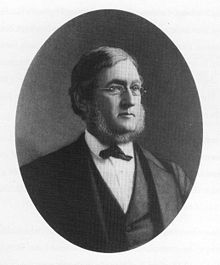Edward Clark (entrepreneur)
Edward Clark (born December 19, 1811 in Athens , New York State , † October 14, 1882 ) was an American lawyer, entrepreneur and patron. He co-founded the Singer sewing machine company and developed the installment purchase plan in 1856, the prototype for installment sales .
Life
Origin and youth
Edward Clark was the eldest of three sons of Nathan Clark (1787–1880) and Julia Nichols (1793–1873). His brothers were Nathan Henry Clark (1816-1817) and Nathan Clark, Jr. (1819-1892). The family originally came from England before Samuel Clark (1615–1690) emigrated to America and settled in what is now Stamford .
Edward Clark's father had potteries in Lyons and Mount Morris founded what products under the brand name & N. Clark Co. sales. Later his brother Nathan Clark Jr. took over the company.
After attending the Lenox Academy in Lenox , Massachusetts , Edward Clark moved to Williams College in Williamstown .
Lawyer
After completing his law degree, he worked as a lawyer in Ambrose Latting Jordan’s office in Hudson , New York. In 1834 he opened his own law firm in Poughkeepsie . On October 21, 1835, he married Caroline Jordan (1815–1874), the daughter of his previous employer. Two years later, Edward Clark and his father-in-law Ambrose Jordan founded the joint law firm Jordan, Clark & Company . They both moved to New York City in 1838.
In 1848 Isaac Merritt Singer became a client of the law firm Jordan & Clark . First of all, the patent rights to his machine for wood and metal processing had to be clarified. In 1851 Singer engaged Edward Clark in a lawsuit over the patent for his sewing machine . Singer had received his own patent, but used components for his machine that Elias Howe had patented. The lengthy process ended in a settlement, according to which Howe received lifelong patent money.
Entrepreneur
In the same year 1851 Isaac Merritt Singer and Edward Clark founded the IM Singer and Company , which later became the Singer Manufacturing Company . Initially, both owned 50% of the company shares and were equal presidents of the company, which by 1855 had become the largest sewing machine manufacturer in the world. With the introduction of the installment plan in 1856, Edward Clark played a key role in the successful further development of the Singer Manufacturing Company . This enabled people with low incomes to purchase a sewing machine and production figures rose significantly. Due to their different personalities, Singer and Clark dissolved their partnership on June 6, 1863 and decided, until the death of one of the two, to forego the presidency of the company. So until Isaac Singer's death in 1875, Inslee Hopper was president of the company, before Edward Clark took over the sole presidency. From the quarreling Singer heirs, Clark subsequently bought up a large number of shares.
Edward Clark began buying real estate as early as 1856. In addition to land in his wife's birthplace in Cooperstown , he continuously acquired land in New York City. In October 1880 he commissioned the architect Henry J. Hardenbergh with the construction of the Dakota Building , which was not completed until after his death.
Patronage and Legacy
Edward Clark had a hospital and the Kingfisher Tower built in Cooperstown while he was still alive . This tower is a lookout point in Otsego Lake, built in the romantic style of the Rhine . In 1880 he donated the Clark Hall to the geological institute of his former university, Williams College .
Edward and Caroline Clark had four children, but three of them died before their father: Ambrose Jordan Clark (1836-1880), Edward Lorraine Clark (1838-1860), Julia Elise Clark (June-Aug. 1841). His youngest son Alfred Corning Clark and his four sons ( Edward Severin Clark , Robert Sterling Clark , Frederick Ambrose Clark , Stephen Carlton Clark ) together inherited the then considerable sum of 50 million US dollars. The grandchildren alone inherited an entire block of houses in Manhattan . In 1888, Alfred Corning Clark donated US $ 50,000 to the then eleven-year-old pianistic prodigy Józef Hofmann to enable him to receive extensive pianistic training up to the age of 18.
literature
- Michael Conforti, James A. Ganz, Neil Harris, Sarah Lees, Gilbert T. Vincent: The Clark Brothers Collect, Impressionist and Early Modern Paintings . New Haven and London 2006 ISBN 0-931102-65-0
| personal data | |
|---|---|
| SURNAME | Clark, Edward |
| BRIEF DESCRIPTION | American entrepreneur, lawyer and patron |
| DATE OF BIRTH | December 19, 1811 |
| PLACE OF BIRTH | Athens , New York , USA |
| DATE OF DEATH | October 14, 1882 |


